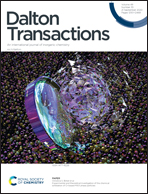A water-soluble bithiophene with increased photoluminescence efficiency and metal recognition ability†
Abstract
A new water-soluble tri-tert-butyl-bithiophenesulfonamide (α2-tbS) was synthesized and a comprehensive spectroscopic and photophysical study was undertaken in organic solvents and water at different pH values. In contrast to the behaviour found for the parent (and un-substituted) α,α′-bithiophene (α2), in which radiationless decay processes are the main excited-state deactivation channels, the tert-butylsulfonamide derivative presents a significant fluorescence quantum yield (ϕF) (ca. one order of magnitude higher than that of α2). The high ϕF allowed further exploring α2-tbS as a selective fluorimetric sensor for metal ions. A strong selectivity towards Cu(II) is observed at neutral pH values, whereas at pH = 9.5 a strong quenching upon the addition of Hg(II) is observed. An additional high sensitivity of 0.64 ± 0.02 ppm towards Cu(II) was observed, well below 1.25 ppm (∼20 μM), the maximum value allowed in drinking water by the EPA.



 Please wait while we load your content...
Please wait while we load your content...